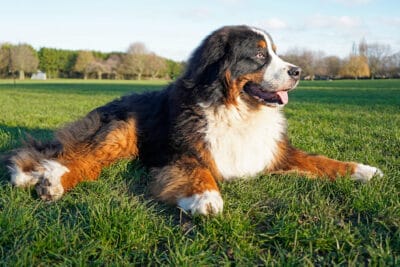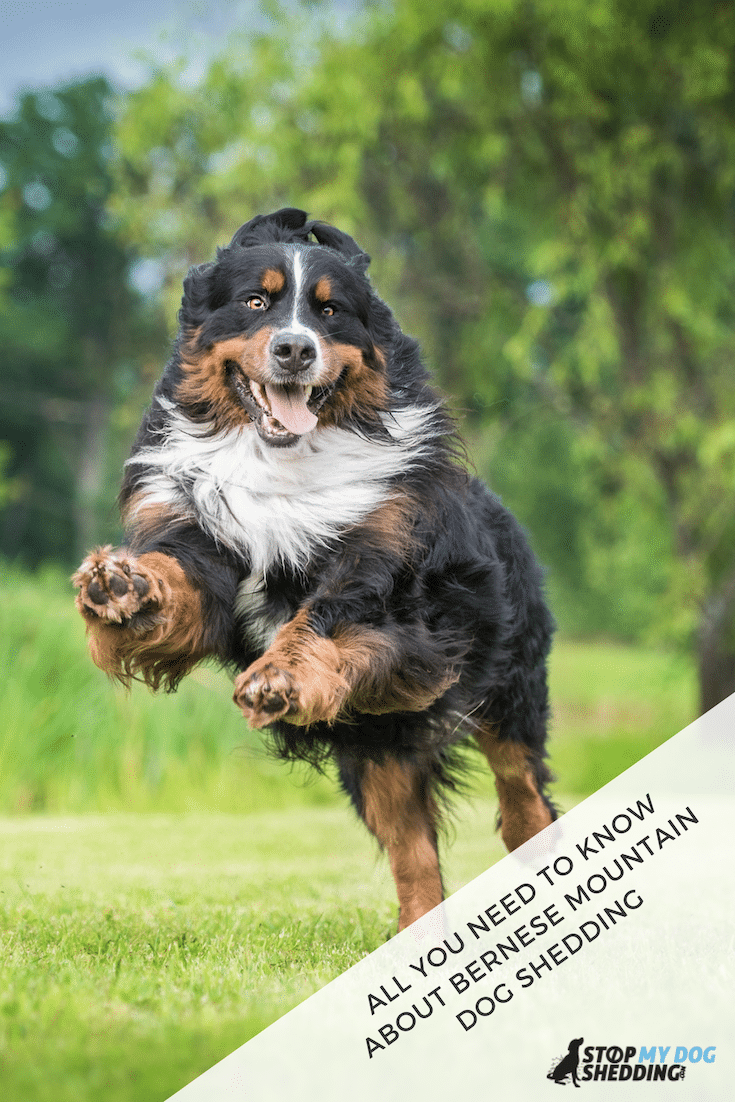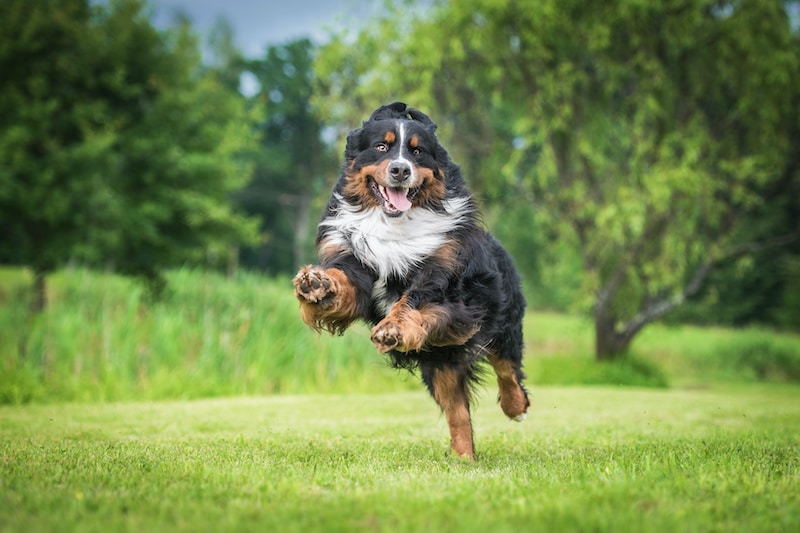Most people, when they see dogs out in the snow, are overwhelmed with sorrow, pity, and compassion. But some dogs, like the Bernese Mountain Dog, were bred to withstand harsh climates. And that is partly due to their thick coats.
So, do Bernese Mountain Dogs shed?
Yes. As a double-coated breed with a long, thick cop coat, these dogs can shed! But regular grooming with the proper tools can help reduce the amount of fur that they drop.
Let’s take a deeper look into where these dogs came from, what their coat is like, and how much effort it will take to keep them well-groomed.
About Bernese Mountain Dogs
Bernese Mountain Dogs are a large breed of dog – and their size is one of the first things you’ll notice. Standing anywhere from 23-28 inches tall, these massive pooches can weigh anywhere from 80 to 110 pounds.
They were originally bred as a cross between guard dogs and Mastiffs, which probably accounts for some of that size!
About 2,000 years ago, these dogs were brought to Switzerland, becoming one of four Swiss Mountain dog varieties. The other three are:
- Appenzeller Sennenhund
- Entlebucher Sennenhund
- Greater Swiss Mountain Dog
They have thick coats, which help them to thrive in cold, harsh climates like those found in the Swiss Alps.
Originally they were brought to help out with farming, which makes sense, as they are great working dogs that possess incredible strength.
In fact, these dogs can pull up to ten times their own body weight! To put that into perspective, that’s 1,000 pounds that a dog can pull – about the equivalent of a fully grown horse!
Things changed in the early 1900s, though, as the breeding of this dog slowed significantly. In 1907, they went from being work dogs to show dogs.
Nowadays, they’re a popular dog breed because they’re helpful and also lovable. They’re a gentle breed, known for being very friendly and, specifically, good with children.
Bernese Mountain Dog Coat Card

| Coat type: | Double coat |
| Texture: | Thick and wooly |
| Length: | Medium-to-long fur |
| Color: | Generally black, tan, and white |
| Shedding: | Heavy-shedding |
| Grooming: | Low-maintenance |
What’s Their Coat Like?
Bernese Mountain Dogs are one of four tri-colored Swiss Mountain dogs. They’re generally black, tan, and white. Their fur is thick, moderately long, and characteristically straight.
They’re also double-coated, which means that they have two layers of fur: one undercoat and one top coat. The undercoat is generally short fur, wool-like in texture; and the top coat has longer hair. This is, in part, why Bernese Mountain Dogs look so fluffy.
This coat suits them well, though, as they were bred to withstand harsh climates. The undercoat helps protect them from hot and cold weather, and the top coat helps repel dirt and moisture.
How Much Do They Shed?
Just by looking at a Bernese Mountain Dog, you would probably assume that they’re going to shed. And if that’s your guess, you’d be right.
Bernese Mountain Dogs are a very high shedding breed.
And because they are large double-coated dogs, they have plenty of fur to drop.
Another thing to consider is that Bernese Mountain Dogs shed seasonally.
Most of the time, the shedding is pretty consistent, but for several weeks during spring and fall, they “blow coat” in preparation for the changing seasons. So you should expect a meaningful increase int he amount of fur they drop during these periods.
Recommended: Go here to see our top-rated dog hair blow dryers
Grooming Your Bernese Mountain Dog
Bernese Mountain Dogs are moderately difficult to groom.
This means that they’re not as easy to brush as a Rhodesian Ridgeback, for example, but they’re also not as difficult to groom as a breed like the Afghan Hound or a Poodle either.
Due to the fact that this is a double-coated breed, grooming is especially important. This is because, if you neglect to groom them, not only will they shed more, but also their undercoat will start to tangle up in their overcoat, resulting in tangled messes and matted fur.
There are also multiple different tools you’ll want to use to really ensure you’re grooming your dog the best you can.
For their undercoat, the best tool for the job is an undercoat rake. This will help get rid of mats, knots, and loose fur right down in the undercoat.
And for their top coat, your best bet is either a de-shedding tool (like the FURminator) or a slicker brush, as these are ideal for removing loose fur from thick-coated dogs.
As for how often you should brush, I’d suggest daily brushing during shedding season and brushing at least 3-4 times per week normally.
Another thing I would (highly) recommend if you’re planning on adopting a Bernese Mountain Dog is a dog hair blower. These are basically blow dryers designed specifically for dogs, and they literally blast away loose fur much quicker and easier than brushing alone can.
And in between daily brushes and weekly coat-blowing sessions, bathing your Bernese Mountain Dog at least once a month can make a world of difference.
Just be careful to use the right dog shampoo, though, as cheap shampoos or human shampoo can cause skin irritation, which can actually result in an increase in shedding.
Other Ways To Reduce Shedding
Aside from establishing a proper grooming routine, you could also speak with your vet about ensuring your Bernese Mountain Dog’s diet is optimal. What your dog eats can make a huge difference to their quality of life and how much fur they drop, so getting this right is worth it.
There are also some great shedding supplements on the market. These should not replace a healthy, balanced diet, but supplementing with things like Omega-3 can help.
And if you’re looking for even more ideas on getting the shedding under control, see our complete guide to reducing excessive dog shedding.
Conclusion
Bernese Mountain Dogs are friendly giants. They’re great with kids and make great companions. At the same time, they’re extremely strong and can be put to good use around a farm.
That said, they do shed (a lot).
And while they’re pretty rugged dogs, because their coats are so thick and wooly, grooming them takes work, especially if you’re determined to keep the shedding under control.
So this definitely is not the dog to get if you don’t want to be cleaning up dog hair frequently. However, if you don’t mind putting in some extra time and effort, this could be the perfect dog for you, as there’s a lot to love about them!
Alternatively, there is a “designer” breed called a Bernedoodle, which is a cross between a Bernese Mountain Dog and Poodle that sheds a LOT less. Poodles are one of the lowest shedders in dogdom, so it’s become common to mix heavier-shedding dogs with Poodles to essentially “breed out” the heavy shedding traits while keeping their more desirable traits.
Whatever you decide, I hope you found this post helpful!













Please note: By submitting a comment using the above comment form, you confirm that you agree with the storage and handling of your data by this site as detailed in our Privacy Policy.